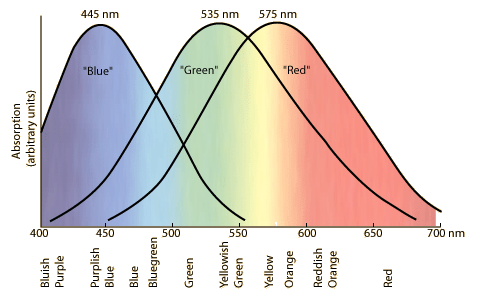Here's a good graphic of how the three cones in our eyes are sensitive to the different parts of the spectrum.
for the rest of the explanation look at http://www.physicsclassroom.com/class/light/Lesson-2/Visible-Light-and-the-Eye-s-Response
Also here is what seems like a pretty reputable and thorough explanation of the blue/white, black gold dress.
http://www.wired.com/2015/02/science-one-agrees-color-dress/
Here is an image Mr Williams put together for his psychology class that is a lot more concise tahn the wired article.
This website should allow you to stay up to date with assignments in the Grant High School Physics classes.
Friday, February 27, 2015
Wednesday, February 25, 2015
Light Unit
Light Unit Goals
1) What is light?
- Be able to describe strengths and weaknesses of the two models of light.
- Be able to give effective examples showing the strengths of each model.
2) How light behaves
- Colors.
- What are primary, secondary and complementary colors.
- How are colors produced by dispersion, addition and subtraction of light.
- Reflection
- What is the law of reflection.
- Be able to locate images and make ray diagrams for reflection from flat mirrors.
- Refraction
- What is it?
- What is Snell’s Law
- How did we determine a law for refraction?
- Be able to solve problems and draw ray diagrams, including for complete internal reflection.
- Lenses
- Be able to draw ray diagrams for converging and diverging lenses.
- Identify images as real or virtual.
Sections in book: most of chapters 16-19
Important Dates:
Homework Sets Due: 3/4, 3/9, 4/7
Refraction Lab due 3/13
Particle Model Lab due 3/19-20
Test 4/9-10
Test 4/9-10
Bev Cleary Presentations4/15-16
Wednesday, February 18, 2015
Monday, February 9, 2015
Speed of Sound Lab
The link below takes you to the questions for the Speed of Sound Lab Report.
Paste them into your lab document and answer them for the next lab report.
https://docs.google.com/document/d/1p0nxp0nsDpM8I6ggPzWdPe98FNx6AAjz3j91H_LJGmc/edit?usp=sharing
Paste them into your lab document and answer them for the next lab report.
https://docs.google.com/document/d/1p0nxp0nsDpM8I6ggPzWdPe98FNx6AAjz3j91H_LJGmc/edit?usp=sharing
Monday, February 2, 2015
Sound Unit
Goals
1. Explain what a wave is.
2. Differentiate between longitudinal and transverse waves
3. Correctly use the vocabulary: medium, pulse, crest, trough, compression, and rarefaction.
4. Define and apply the following wave characteristics: period, frequency, velocity, wavelength, amplitude, and energy.
5. Apply the following relationships: T=1/f and v =f*wavelength.
6. Explain how standing waves are produced and correctly use the terms nodes and antinodes.
7. Explain the following wave behaviors, interference, beats, resonance, doppler effect and sonic booms.
Key dates:
Online Homework : due Wednesday 2/18
Speed of sound lab : performed 2/11-12. due: negotiable, but probably 2/19-20
Test 2/19-20
1. Explain what a wave is.
2. Differentiate between longitudinal and transverse waves
3. Correctly use the vocabulary: medium, pulse, crest, trough, compression, and rarefaction.
4. Define and apply the following wave characteristics: period, frequency, velocity, wavelength, amplitude, and energy.
5. Apply the following relationships: T=1/f and v =f*wavelength.
6. Explain how standing waves are produced and correctly use the terms nodes and antinodes.
7. Explain the following wave behaviors, interference, beats, resonance, doppler effect and sonic booms.
Key dates:
Online Homework : due Wednesday 2/18
Speed of sound lab : performed 2/11-12. due: negotiable, but probably 2/19-20
Test 2/19-20
Subscribe to:
Posts (Atom)

